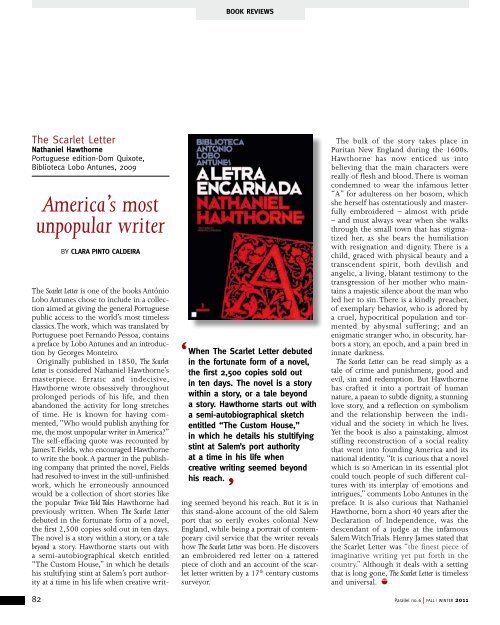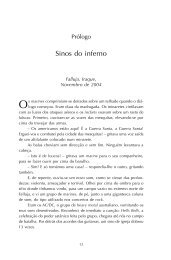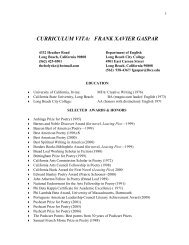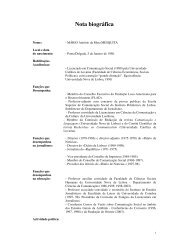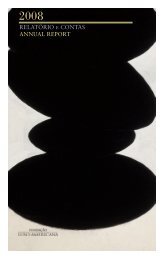A decade later - Fundação Luso-Americana
A decade later - Fundação Luso-Americana
A decade later - Fundação Luso-Americana
You also want an ePaper? Increase the reach of your titles
YUMPU automatically turns print PDFs into web optimized ePapers that Google loves.
The Scarlet Letter<br />
nathaniel Hawthorne<br />
Portuguese edition‑Dom Quixote,<br />
Biblioteca Lobo Antunes, 2009<br />
America’s most<br />
unpopular writer<br />
82<br />
By cLArA pinTo cALdeirA<br />
The Scarlet Letter is one of the books António<br />
Lobo Antunes chose to include in a collection<br />
aimed at giving the general Portuguese<br />
public access to the world’s most timeless<br />
classics. The work, which was translated by<br />
Portuguese poet Fernando Pessoa, contains<br />
a preface by Lobo Antunes and an introduction<br />
by Georges Monteiro.<br />
Originally published in 1850, The Scarlet<br />
Letter is considered Nathaniel Hawthorne’s<br />
masterpiece. Erratic and indecisive,<br />
Hawthorne wrote obsessively throughout<br />
prolonged periods of his life, and then<br />
abandoned the activity for long stretches<br />
of time. He is known for having commented,<br />
“Who would publish anything for<br />
me, the most unpopular writer in America?”<br />
The self-effacing quote was recounted by<br />
James T. Fields, who encouraged Hawthorne<br />
to write the book. A partner in the publishing<br />
company that printed the novel, Fields<br />
had resolved to invest in the still-unfinished<br />
work, which he erroneously announced<br />
would be a collection of short stories like<br />
the popular Twice Told Tales Hawthorne had<br />
previously written. When The Scarlet Letter<br />
debuted in the fortunate form of a novel,<br />
the first 2,500 copies sold out in ten days.<br />
The novel is a story within a story, or a tale<br />
beyond a story. Hawthorne starts out with<br />
a semi-autobiographical sketch entitled<br />
“The Custom House,” in which he details<br />
his stultifying stint at Salem’s port authority<br />
at a time in his life when creative writ-<br />
BooK revieWs<br />
‘ When The scarlet Letter debuted<br />
in the fortunate form of a novel,<br />
the first 2,500 copies sold out<br />
in ten days. The novel is a story<br />
within a story, or a tale beyond<br />
a story. Hawthorne starts out with<br />
a semi-autobiographical sketch<br />
entitled “The custom House,”<br />
in which he details his stultifying<br />
stint at salem’s port authority<br />
at a time in his life when<br />
creative writing seemed beyond<br />
his reach.<br />
’<br />
ing seemed beyond his reach. But it is in<br />
this stand-alone account of the old Salem<br />
port that so eerily evokes colonial New<br />
England, while being a portrait of contemporary<br />
civil service that the writer reveals<br />
how The Scarlet Letter was born. He discovers<br />
an embroidered red letter on a tattered<br />
piece of cloth and an account of the scarlet<br />
letter written by a 17 th century customs<br />
surveyor.<br />
The bulk of the story takes place in<br />
Puritan New England during the 1600s.<br />
Hawthorne has now enticed us into<br />
believing that the main characters were<br />
really of flesh and blood. There is woman<br />
condemned to wear the infamous letter<br />
“A” for adulteress on her bosom, which<br />
she herself has ostentatiously and masterfully<br />
embroidered – almost with pride<br />
– and must always wear when she walks<br />
through the small town that has stigmatized<br />
her, as she bears the humiliation<br />
with resignation and dignity. There is a<br />
child, graced with physical beauty and a<br />
transcendent spirit, both devilish and<br />
angelic, a living, blatant testimony to the<br />
transgression of her mother who maintains<br />
a majestic silence about the man who<br />
led her to sin. There is a kindly preacher,<br />
of exemplary behavior, who is adored by<br />
a cruel, hypocritical population and tormented<br />
by abysmal suffering; and an<br />
enigmatic stranger who, in obscurity, harbors<br />
a story, an epoch, and a pain bred in<br />
innate darkness.<br />
The Scarlet Letter can be read simply as a<br />
tale of crime and punishment, good and<br />
evil, sin and redemption. But Hawthorne<br />
has crafted it into a portrait of human<br />
nature, a paean to subtle dignity, a stunning<br />
love story, and a reflection on symbolism<br />
and the relationship between the individual<br />
and the society in which he lives.<br />
Yet the book is also a painstaking, almost<br />
stifling reconstruction of a social reality<br />
that went into founding America and its<br />
national identity. “It is curious that a novel<br />
which is so American in its essential plot<br />
could touch people of such different cultures<br />
with its interplay of emotions and<br />
intrigues,” comments Lobo Antunes in the<br />
preface. It is also curious that Nathaniel<br />
Hawthorne, born a short 40 years after the<br />
Declaration of Independence, was the<br />
descendant of a judge at the infamous<br />
Salem Witch Trials. Henry James stated that<br />
the Scarlet Letter was “the finest piece of<br />
imaginative writing yet put forth in the<br />
country.” Although it deals with a setting<br />
that is long gone, The Scarlet Letter is timeless<br />
and universal.<br />
Parallel no. 6 | FALL | WINTER 2011


